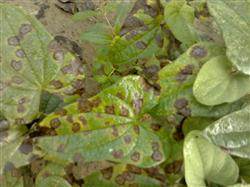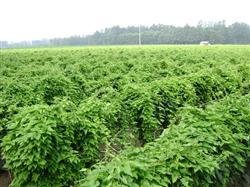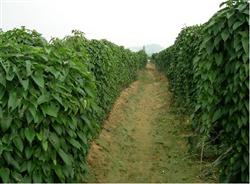What are the methods of planting Chinese yam to control diseases and insect pests?

What are the ways to control pests? Please give an introduction to the method of planting yam can be used to control diseases and insect pests in the following ways: 1. Agricultural control 1. The selection of disease-resistant varieties is an effective way to control yam diseases and insect pests. When planting disease-resistant varieties, rational distribution should be made, varieties should be rotated every 2~3 years, and attention should be paid to the purification and rejuvenation of varieties. 2. Crop rotation can reduce or avoid stem rot and root knot nematode damage of yam. Rotation with corn, wheat, radish, watermelon and other crops that are not infected shall be carried out at least once every 3 years; rotation shall be carried out once a year in old areas where yam is cultivated all the year round; rice-drought rotation can be carried out in areas where conditions permit, so as to achieve better control effect. 3. Soil preparation can directly eliminate pathogenic bacteria overwintering in soil. Selecting fertile loose sandy loam with high dry terrain and low humidity for soil preparation in autumn can turn over the sick and disabled bodies left on the ground into soil, accelerate the decomposition and decay of the sick and disabled bodies, and make some pathogens lose their vitality after winter freezing and spring drying. 4. Fertilization, irrigation yam is a fertilizer-loving crop, in the preparation of soil must apply decomposed organic fertilizer. Generally, phosphorus and potassium fertilizer are beneficial to the formation of yam mechanical tissue and enhance the ability to resist pathogenic bacteria. Too much nitrogen fertilizer, easy to cause excessive plant growth, stem and leaf tissue soft, easy to get yam anthracnose. The principle of watering is "no drought, no watering". Clean water should be used when watering. It must be watered thoroughly. There should be no accumulated water in the field. Drainage should be carried out in time in rainy season to avoid root rot. 5. Field surface cleaning field weeds had better be eradicated manually. Removing the leaves and stems of diseased yam in time can reduce the reinfection of pathogens. When yam is harvested, the sick bodies, weeds and rotten stems left on the ground should be burned or buried deeply outside the field to reduce overwintering pathogens. Second, chemical control 1. yam anthracnose harm stems and leaves caused by stem blight, deciduous. Control method: seed potato with 1∶1∶150 wave of multi-solution soaking for 10 minutes. 50% carbendazim 600 times solution was sprayed for the first time when seedling was complete, and the second time was sprayed after 10 days. From July to August, 500-fold solution of 65% manineb WP, 800 - 1000-fold solution of 50% tuijunte WP and 700 - 800-fold solution of 50% thiophanate-methyl were sprayed alternately for 2 - 4 times according to the severity of the disease. Every time 8~10 days interval, after the rain should be sprayed liquid medicine. 2. Short body nematode disease causes dwarfing of plants, yellow and dead in severe cases; tuber damage causes small nodules of different sizes, affecting yield and quality. Control method: Before sowing, treat the soil with pesticide, mix 5kg of 5% methamidophos granules with 100kg of moist fine soil per mu, ditch evenly spread on both sides of seed potato, or evenly spread in combination with soil preparation, 25~ 30cm into the soil. 3. Tenthreds bite yam leaves, causing serious leaf loss, affecting photosynthesis and reducing tuber yield. Kill with 2% trichlorfon 3000 times solution or 90% crystalline trichlorfon 1000 times solution stem spray. 4. Grubs bite tubers, making them not rotten and bitter. Control by soil treatment, 50% phoxim 250- 300ml per mu, 25kg fine soil mixed and then scattered into the ridge, after application immediately inserted into the 20cm soil layer, and then planted yam seeds. Click for more yam growing techniques Click for more vegetable growing techniques
- Prev

How to fertilize yam planting?
How to fertilize yam planting? Please give an introduction to the main long branches and leaves of yam seedling stage and vine stage. The fertilizer is mainly nitrogen. After budding, it enters the peak growth stage. The underground tubers begin to expand. The amount of fertilizer required is large. It is the key period for fertilization. Nitrogen, phosphorus and potassium should be applied together. 1. Base fertilizer. Select the field, apply per acre before ploughing...
- Next

What do you need to pay attention to when planting hemp yam?
What do you need to pay attention to when planting hemp yam? Please guide the cultivation of yam to pay attention to the following points: 1. Soil requirements: the land with flat ground, loose soil, deep soil layer, strong water and fertilizer conservation capacity and easy drainage should be selected, and sandy loam, light loam and loam are the most suitable soil. 2. Selection of varieties and seedlings.
Related
- Where is it suitable to grow horseradish in China? it is expected to see the middle altitude horseradish in Alishan.
- How to prevent tomato virus disease reasonably? (Control methods included)
- Many people like to plant towel gourd on the balcony. What are the main points of this method and management?
- What crops can chili peppers be mixed with?
- Fertilization techniques and matters needing attention in Tomato
- What are the grafting techniques for peach seedlings in spring?
- Harm and control methods of root swelling disease of Chinese cabbage
- What are the pests of sweet potatoes? How to prevent and cure it?
- Symptoms, causes and Control methods of navel Rot in Tomato
- The cause of "Cucumber rotten bibcock" in Farmers' planting Cucumber and its Control Plan

